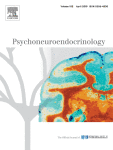Some food for thought for tonight’s meeting. I’ve come across a couple of interesting articles and studies on hormones and psychopathy, which is discussed briefly in Ch 28 Part 2. One is on low serum cholesterol (an article on SoTT):

 www.sott.net
www.sott.net
And this study on the hormone oxytocin (often dubbed the cuddle hormone)- looking at daily output of oxytocin in primary (genetic) vs. secondary (adverse environment) psychopaths:

 www.sciencedirect.com
www.sciencedirect.com
It’s a very interesting study and is free to view. It reinforces the notion of the harm done from emotionally detached parenting as described in Healing Developmental Trauma.

Does Low Serum Cholesterol Cause Psychopathy?
Strange as it may seem, low cholesterol could be a significant factor, maybe even the cause, of psychopathy. I got to thinking about this as a result of reading an article about psychopathy in the current New Yorker, in which we learn about a...
Low cholesterol is strongly associated with criminality, as is psychopathy. At least one prominent researcher in the field of psychopathy believes that psychopaths have a defect in the paralimbic system, which is responsible for memory and negative emotions such as guilt. Psychopaths notoriously do not suffer from guilt. Cholesterol-lowering drugs can cause memory loss and aggression. Therefore, low serum cholesterol is implicated in psychopathy. Q.E.D.
Now the question is, just how much is heredity and how much environmental? Is the widespread and longstanding recommendation to cut the fat out of our diets and to ensure a low cholesterol level causing an increase in the number of psychopaths? (If it is, those low-fat diet folks have a lot to answer for, more than they ever would have dreamed.) Does the widespread prescribing of statins increase the fraction of psychopaths in the population? Wouldn't surprise me.
And this study on the hormone oxytocin (often dubbed the cuddle hormone)- looking at daily output of oxytocin in primary (genetic) vs. secondary (adverse environment) psychopaths:

Daily oxytocin patterns in relation to psychopathy and childhood trauma in residential youth
Inconsistent findings have been found on the relation between oxytocin levels and psychopathy or callous-unemotional (CU) traits in humans, potentiall…
Our study provided the first evidence of distinct oxytocin output in primary and secondary psychopathy. Subjects with high CU traits and low levels of emotional neglect (indicative of primary psychopathy) exhibited lower oxytocin output compared to subjects with high CU traits and high emotional neglect (indicative of secondary psychopathy). This finding supports our hypothesis that primary psychopathy might be characterized by lower oxytocin concentrations compared to secondary psychopathy. Primary psychopathy is characterized by more severe affective deficits and biological underpinnings, whereas secondary psychopathy is related to emotional problems and stems from adverse experiences (Karpman, 1941; Poythress and Skeem, 2006). Limited previous evidence also supported a negative association between CU traits and oxytocin levels in adolescents (Levy et al., 2015), but did not take into account the role of trauma and the distinction between primary and secondary psychopathy. Our findings showed that low oxytocin output might be especially related to primary psychopathy as indicated by high CU traits in combination with low trauma, contributing to the evidence supporting a stronger biological background of primary psychopathy.
Given the role of oxytocin in the development of the social brain and the processing of social information (Hurlemann and Scheele, 2016; Shamay-Tsoory and Abu-Akel, 2016; Vaidyanathan and Hammock, 2016), it is possible that the lower oxytocin levels observed in subjects with primary psychopathy may partially inhibit the successful development of the social brain and the modulation of successful social behaviors, which may lead to social-affective deficits. If oxytocin expression in the brain is limited at an early age, it might impede the processing of social stimuli and the development of cortical plasticity that contributes to the formation of social-affective behaviors and social relationships, which in turn might lead to the development of primary psychopathy. Conversely, in secondary psychopathy oxytocin expression might be intact and these fundamental processes might have been successfully developed, but the psychopathic traits are expressed as a coping mechanism to deal with emotional distress. However, this interpretation cannot be substantiated by our cross-sectional findings, but future studies measuring oxytocin secretion at an early age could gain insight into the development of the oxytocin system.
Interestingly, the interaction between CU traits and trauma was found only for emotional neglect and not for the other trauma types. Emotional neglect refers to an adverse family environment, which is inadequate to satisfy the child’s psychological and emotional needs. Neglectful parents exhibit limited and insufficient parent-child interactions, emotional support, and affective exchange, which could lead to affective deficits in their children. This emotionally neglectful and cold family environment can lead to the development of psychopathy and especially CU traits that are predominantly characterized by affective deficits (McCord and McCord, 1956). Relatedly, cumulative evidence has shown that insecure attachment style and emotionally detached parent-child relationship were associated with psychopathy (Bailey and Shelton, 2014). Therefore, emotional neglect seems to play a crucial role in the development of CU traits and especially secondary psychopathy that can make the distinction between the two variants as well as the distinct oxytocin patterns more clear. In line with previous findings, adverse environment might contribute to secondary psychopathy, whereas biological factors might be more relevant for primary psychopathy.
It’s a very interesting study and is free to view. It reinforces the notion of the harm done from emotionally detached parenting as described in Healing Developmental Trauma.



